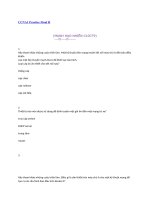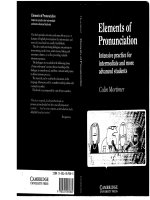Woolcot LPG tanker practice 1977
Bạn đang xem bản rút gọn của tài liệu. Xem và tải ngay bản đầy đủ của tài liệu tại đây (3.33 MB, 128 trang )
LIQUIFIED PETROLEUM GAS
TANKER PRACTICE
Captain T. W. V. WOOLCOTT
GLASGOW
BROWN, SON & FERGUSON LTD., NAUTICAL PUBLISHERS 52 DARNLEY
STREET, GLASGOW G41 2SG
I
PREFACE
The purpose of this book is to provide a guide to the conduct of the transportation
of liquified petroleum gases and ammonia, the coverage of which has not so far
been available in a single volume.
It is hoped that it will be useful not only to those operating the carriers but also
to the staffs of terminals handling these products.
Although some treatment is given to the equipment involved, it is not intended
that this book shall be a technical guide.
I would like to acknowledge the assistance given by Mr. W. R. H. Walters in the
preparation of the book and a general acknowledgement of the assistance I have
had over a number of years from the officers of the various vessels in which I have
served, and also the management of Messrs. Houlder Brothers and Company
Limited of London.
T. W. V. WOOLCOTT April, 1977
II
INTRODUCTION
INTRODUCTION
The purpose of this book is to examine the technical problems involved in the
transportation of L.P.G. and ammonia cargoes, and various other aspects of the
running of L.P.G. Tankers.
The detailed procedures at all stages will depend upon the conditions under
which the cargoes are to be loaded, carried and discharged—whether under fullypressurised, semi-pressurised, or fully-refrigerated at atmospheric pressure
conditions.
1. Preparation: At the point of loading, the cargo tanks should have been prepared,
so far as is possible, for the reception of the cargo to be carried. The procedure
involved, and the degree of readiness would depend upon whether the vessel is
loading:
(a) a consecutive cargo of the same type;
(b) a cargo of a different nature, but compatible with the previous cargo, e.g.
butane after propane;
(c) a cargo of a different nature, and incompatible with the previous cargo (e.g.
to load propane after discharging ammonia would involve gas-freeing); or
(d) a first cargo.
2. Loading: This involves differing procedures, depending upon the facilities
offered at the loading terminal, e.g. whether or not a vapour return line (see
Glossary) is provided. It covers calculations for ascertaining the correct
soundings (depths of liquid) to load either a full cargo or a given quantity (part
cargo), and to calculate afterwards as accurately as possible the quantity in fact
loaded.
3. Transportation: This covers care of the cargo in transit to guard against loss of
product; the running of the reliquifaction plant and ensuring that the cargo tanks
do not become over-full due to the incorrect operation of the condensate returns
from the reliquifaction plant; and the routine checking of tank pressures and
adjusting the degree of refrigeration accordingly so that the vessel is ready to
discharge on arrival at the terminal.
4. Discharging: The method of discharge will depend upon the facilities for
discharge available at the receiving terminal, and the type of discharge required
—if direct into fully-refrigerated storage or via the cargo heater into pressure
storage.
Special Safety Precautions
Due to the hazardous nature of the cargoes carried, those responsible for the
conduct of Liquified Gas Tanker operations have a particular responsibility, not
only to preserve the lives of those on board, but particularly to preserve the
environment at the terminals and their approaches. A fire, once it gets a firm hold,
and particularly if it spreads to the cargo tanks, would present a very serious
hazard, since it would be extremely difficult to extinguish. So fire prevention is of
the greatest importance. The chapter on Safety lays particular emphasis on this and
covers:
III
INTRODUCTION
(a) safe navigation;
(b) safe practice (incorporated in the chapters dealing with the operating
procedures);
(c) efficient detection of an accumulation of gas before it reaches a flammable
mixture;
(d) rapid fire detection so that a fire can be tackled in its early stages;
(e) fire fighting.
The chapter also covers the special dangers which may be encountered when
entering a compartment which has previously been inerted with nitrogen even
though it has since been ventilated, and the precautions which should be taken. This
is fully explained in Chapter X.
One of the peculiarities of operating Liquified Gas Carriers is that the cargo is
completely unseen whilst it is being loaded, carried and discharged. A firm
knowledge of the scientific laws relating to the behaviour of gases, both in the
vapour and liquid form, is therefore essential because the successful operator must
be able rapidly to recognise symptoms, diagnose the trouble and take action to cure
the problem without delay. The gas behaviour laws also have a great significance
with regard to safe working practice.
Although the gas behaviour laws are invariable, their application when used in
respect of fully-pressurised/semi-pressurised ships, as opposed to fully-refrigerated
gas tankers, is very different. This affects both the design of the two different types
of gas carriers, as well as their respective method of operation, to such an extent
that the book is divided into two main parts. Part I covers the fully-pressurised
semi-pressurised types of carriers, and Part II the fully-refrigerated type. which
always carry their cargoes at about atmospheric pressure. Part III deals with such
general matters as Cargo Calculations and Safety.
The book concludes with suggestions horn of experience for improvements
which would free the operators of much of the embarrassment they now frequently
experience. They are particularly directed to the attention of those responsible for
the design of the ships, higher management and the legislature.
IV
L.P.G. TANKER PRACTICE
TABLE OF CONTENTS
Page Introduction........................................................................................... III
PART I—PRESSURE SHIPS
Chapter I
General Description..................................................................1
Chapter II
General Operating Principles....................................................6
Loading.................................................................................7
Discharging...........................................................................7
Refrigerating the Cargo.........................................................8
Gas-freeing...........................................................................9
Chapter III Cargo Handling Equipment.......................................................10
Cargo Pumps.........................................................................10
Cargo Compressors...............................................................11
Condensers............................................................................14
Heat Exchangers...................................................................16
Cargo Heater.........................................................................17
Vaporiser...............................................................................17
Chapter IV
Conduct of Cargo Operations....................................................18
Semi-refrigerated Cargoes....................................................18
Loading.................................................................................18
Discharging...........................................................................20
Refrigerating the Cargo.........................................................21
Gas-freeing...........................................................................22
Fully-refrigerated Cargoes at Atmospheric Pressure.............24
Loading.................................................................................24
Discharging...........................................................................25
Two-stage Refrigeration........................................................27
Precautions to be taken When Starting a Compressor...........29
Points to Watch Whilst a Compressor is Running.................30
V
L.P.G. TANKER PRACTICE
PART II—FULLY-REFRIGERATED SHIPS
Chapter V
General Description..................................................................31
Chapter VI General Operating Principles....................................................38
Loading.................................................................................38
Refrigerating the Cargo on Passage......................................38
Two-stage Reliquifaction......................................................38
Cascade Reliquifaction.........................................................39
Discharging...........................................................................41
Gas-freeing...........................................................................42
To Gas-up the Tanks After They Have Been Gas-freed........44
To Cool Down the Tanks Prior to Loading............................45
Summary of Gas-freeing and Gassing-up.............................46
Chapter VII Cargo Handling Equipment.......................................................48
Two-stage Refrigeration........................................................48
Two-stage Compressors........................................................48
Seawater-Cooled Condensers................................................52
The Inter-stage Cooler..........................................................52
The Heat Exchanger..............................................................53
Cascade System of Refrigeration..........................................53
R.22 Compressors.................................................................54
R.22 Condensers...................................................................54
R.22 Receivers......................................................................54
The Cargo Compressors........................................................55
The Cargo Condensers..........................................................57
Methanol Injection System...................................................58
Vaporisers.............................................................................59
Air Dryer...............................................................................63
Cargo Heaters.......................................................................63
Submerged Cargo Pumps......................................................65
Emergency Cargo Pumps......................................................68
Deck Storage Tanks..............................................................69
Chapter VIII Cargo Operating Procedure.......................................................71
Loading.................................................................................71
To Refrigerate the Cargo on Passage....................................74
Two-stage Reliquifaction......................................................74
VI
L.P.G. TANKER PRACTICE
Points to Watch Whilst the Plant is Running.................................76
Cascade System of Reliquifaction.................................................77
Starting the Compressors...............................................................78
Points to Watch Whilst the Plant is Running.................................80
To Shut Down the System.............................................................80
Other Points to Watch....................................................................81
Discharging...................................................................................81
To Gas-free the Vessel...................................................................82
Puddle Heating..............................................................................82
To Estimate the Time it Will Take to Puddle Heat.........................83
Tank Warming...............................................................................84
Inerting the Cargo Tanks................................................................84
Flushing Through with Air............................................................85
Preparing the Tanks to Receive Cargo After They
Have Been Gas-freed.....................................................................85
Drying the Air in the Cargo Tanks.............................................85
To Operate the Air Dryer...........................................................86
To Inert the Tanks Prior to Gassing-up......................................86
To Gas-up the Cargo Tanks (at Sea)..........................................86
To Gas-up the Tanks Alongside.................................................87
Cooling Down the Cargo Tanks................................................87
Procedure When Changing Grades and Types of Cargo................88
VII
L.P.G. TANKER PRACTICE
PART III—GENERAL
Chapter IX Cargo Calculations....................................................................89
To Calculate the Quantity of Liquid on Board (Metric)........90
To Calculate the Weight of Vapour on Board
(Imperial and Metric)............................................................91
Assessing the Volume of Vapour...........................................92
To Calculate the Quantity of Liquid on Board
(Imperial)..............................................................................93
To Calculate the Correct Volume of Liquid
to Load When Loading a Full Cargo.....................................94
Expansion Relief Valves on Liquid Lines.............................95
To Calculate the Correct Volume of Liquid
to Load When Loading a Part Cargo.....................................95
To Calculate the S.V.P. of a Mixture of Products
at a Given Temperature.........................................................96
To Calculate the Individual Proportions of Vapour
In the Vapour Mixture Above a Liquid Mixture....................97
Molecular Weights ...............................................................97
Aid to Memorising the Formulae..........................................98
Comparison of Metric and Imperial Systems........................98
Table of Properties................................................................100
Chapter X
Safety........................................................................................102
Safe Navigation.....................................................................102
Safe Practice.........................................................................103
Gas Detection........................................................................103
Fire Detection.......................................................................104
Fire-fighting..........................................................................104
Precautions to be Taken when Entering Spaces
Which May Have a Deficiency of Oxygen...........................106
Chapter XI
Recommendations....................................................................108
Safe Navigation.....................................................................108
Harbour Control....................................................................109
Enforcement of Traffic Separation Systems..........................109
Emergency Isolation Valves for Safety Valves......................109
Greater Consultation between Operators and
Design Staff..........................................................................110
GLOSSARY OF TERMS USED........................................112
VIII
L.P.G. TANKER PRACTICE
LIST OF DIAGRAMS
No.
Page
1. Semi/Fully-refrigerated liquid gas carrier...................................................2
2. Arrangement of pipework in cargo tank......................................................2
3. Tank dome penetration................................................................................2
4. L.P.G. and motor rooms showing arrangement of gas-tight
bulkhead and gas-tight seals.......................................................................4
5. Simple vapour line arrangement.................................................................4
6. Tank discharging arrangements...................................................................5
7. Single stage compressor..............................................................................12
8. Single stage refrigeration............................................................................15
8A. Incondensible Separator or Purge Condenser...........................................15
9. Two-stage reliquifaction using 3 single stage compressors.........................28
10. Fully-refrigerated L.P.G. tanker................................................................32
11. Schematic view of cargo tank ..................................................................36
12. Schematic diagram of cascade system of refrigeration.............................40
13. Two-stage compressor..............................................................................50
14. Two-stage refrigeration.............................................................................51
15. Double-acting single stage compressor.....................................................56
16. Vaporiser type "A"....................................................................................60
17. Vaporiser type "B"....................................................................................62
18. Air dryer....................................................................................................64
19. Gas/air heater............................................................................................64
20. Cargo heater type "A"...............................................................................66
21. Cargo heater type "B"...............................................................................66
22. Submerged cargo pump............................................................................67
23. Loading (cartoon).....................................................................................73
24. Graph of Temp./Vapour Pressure Relation Ships......................................101
IX
L.P.G. TANKER PRACTICE
GLOSSARY OF TERMS USED
(pages 112-118)
Boiling
Boiling Temperature
Condensation
Evaporation
Filling of Tanks
Gas/Vapour
Flammable or Explosive Mixture
Flash Point
Ignition Temperature Gas Laws
Avogadro's Hypothesis
Boyle's Law
Charles's Law
Clerk Maxwell's Kinetic Theory
Dalton's Law of Partial Pressures
Gay Lussac's Law
Joule's Law Heat
Latent Heat
Sensible Heat Heel
Liquid Carry Over Mole Pressure
Absolute Pressure
Gauge Pressure
Atmospheric Pressure Span Gas Stratification Temperature
Absolute Temperature
Adiabatic Changes in Temperature
Critical Temperature
Vaporisation
Batch Vaporisation
Flash Vaporisation Vapour
Saturated Vapour Pressure (S.V.P.)
Supersaturated Vapour
Undersaturated Vapour
Superheated Vapour Vapour Return Line Zero Gas
X
L.P.G. TANKER PRACTICE
PART I PRESSURISED SHIPS
CHAPTER I: GENERAL DESCRIPTION
Pressure ships can be divided into two types, namely fully-pressurised and semipressurised (semi-refrigerated). In practice, the designation of the two types of
vessels has been contracted to Pressure Ships to describe fully-pressurised L.P.G.
tankers, and semi-refrigerated to describe semi-pressurised ships. From this point
on, this terminology will be used.
Pressure ships are the simplest vessels, and were the first to be built or
converted, for the specific purpose of carrying L.P.G./Ammonia cargoes. The cargo
is carried in a number of cylindrical pressure vessels (cargo tanks) capable of
withstanding the maximum pressure likely to be met in service, (usually about 17
bars), the arrangement of the tanks being indicated in Fig. 1.
In order to act as a liquified gas carrier, the ship must be capable of loading,
carrying and discharging its cargoes, as well as having provision for gas-freeing for
repairs or when changing types of cargo to be carried.
In liquified gas vessels, no joints, glands, etc., are permitted below decks, in
order to exclude the possibility of liquified gas or vapour leaking unnoticed below
decks, so special arrangements have to be made to conform to this requirement.
This means that the loading/discharging (liquid) lines have to penetrate the tank
through the tank dome protruding through the deck. The arrangement is shown in
Fig. 3.
To drive the liquified gas from the bottom of the tank to the cargo pump suction,
compressors are installed which, by taking vapour from a tank not being
discharged (or from shore through a vapour return line), pressurise the tanks being
emptied and drive the liquid to the pump suction. Therefore a pressure type
liquified gas tanker is provided with:
(a) strong tanks (or pressure vessels) into which the cargo is loaded;
(b) a liquid line leading from the top of the cargo tank to the bottom through
which the liquid gas cargo is loaded and discharged (these are also used for
gas-freeing);
1
L.P.G. TANKER PRACTICE
2
L.P.G. TANKER PRACTICE
(c) compressors with which to pressurise the tanks being discharged in order to
blow the cargo from the bottom of the tank to the cargo pump suction;
(d) a vapour line leading to the top of the cargo tanks which is used by the
compressors to pressurise the tanks being discharged;
(e) cargo pumps to raise the discharge pressure and so pump the cargo ashore;
and
(f) a liquid manifold to which the shore loading/discharge lines are connected,
and linked to the ship's liquid line system, together with a vapour line
connection which can be linked to the shore vapour line (if provided) and
used either as a vapour source when discharging or pressure relief when
loading.
The principal advantage of semi-refrigerated ships (semi-pressurised) is that
the tanks containing the cargo need not be so strong because the pressure of the
cargo is very much reduced by lowering its temperature. As a result, the following
benefits are derived:
(a) more cargo can be carried in a tank of the same capacity (see Chapter IX—
Cargo Calculations);
(b) a tank of the same capacity is lighter and cheaper to construct; and
(c) much larger and more economical tanks can be constructed.
Pressure ships usually range from very small capacity up to 2,000 cubic metres
capacity. The capacity of semi-refrigerated ships usually range from between 1,000
to over 10,000 cubic metres. The cargo in the tanks is usually maintained at about
0° C. by a process of refrigeration, and the tanks themselves are thermally
insulated.
The loading and discharging procedures are generally similar in both types, the
main operating difference being the addition in the semi-refrigerated ship of a
reliquifaction (refrigerating) plant to cool the cargo on passage, and also under
certain circumstances, to assist with loading.
In most vessels of both types, the cargo handling equipment is located in a
deckhouse divided into two compartments by a gas-tight bulkhead. In the one half
are located the electric motors to drive the compressors and pumps, which are
separately housed in the other section, the driving shafts passing through the gastight bulkhead via gas-tight seals (see Fig. 4). The motor room is kept pressurised
with air by powerful fans to exclude the possibility of gas entering the motor room,
so avoiding a fire hazard.
3
L.P.G. TANKER PRACTICE
The tanks are usually discharged two at a time by blowing the liquid gas to the
cargo pump suction, where the discharge pressure is greatly increased by the cargo
pump.
To blow the liquid gas to the pump, one or more compressors are started up.
sucking vapour from one or more tanks not being discharged and sending it into the
tanks being emptied. This is shown in Fig. 6. A simple vapour line arrangement to
do this shown in Fig. 5, but in more advanced ships (particularly the semirefrigerated ships) different arrangements are made to achieve the same result,
often using different piping arrangements, hut the principle of pressurising the
tanks being discharged and blowing the product to the pump suction remains the
same.
The latest development is to make semi-refrigerated ships capable of carrying
fully-refrigerated cargoes at atmospheric pressure, which gives them greater
versatility with regard to the cargoes that can be carried. Hence, a simple general
description of the all-purpose ship will cover individual types.
4
L.P.G. TANKER PRACTICE
5
L.P.G. TANKER PRACTICE
CHAPTER II: GENERAL OPERATING PRINCIPLES
The cargo system of a typical semi-refrigerated gas carrier consists of a number of
cylindrical tanks strong enough to withstand the maximum pressure of the cargo it
is intended to carry at the maximum carrying temperature envisaged. If, for any
reason, the pressure rises above this limit, then safety valves lift and relieve the
excess pressure.
The arrangement of the pipework in the cargo tanks is depicted in Fig. 2 and
consists of:
(a) A liquid line through which the liquid gas is loaded and discharged. It leads
to the bottom of the tank.
(b) A vapour line through which vapour is withdrawn from the top of the tank,
and which leads to the compressor suction.
(c) A condensate spray line which has the multiple function of:
(i) Returning condensate from the condenser to the tank when it is being
refrigerated. The returned condensate is usually sprayed into the tank
through the upper spray.
(ii) As a vapour line connected to the discharge side of the compressors, and
through which the tank can be pressurised for discharging purposes.
(iii) As a spray line to reduce pressure when loading. It will be noticed that
there are two spray lines—the upper spray which is fairly coarse, and a
much finer middle spray. The holes in the middle spray line are directed
upwards, and the middle spray line is used to pre-cool the tanks when it is
intended to load a very cold cargo.
(d) A relief line which leads up the mast, and to which at least 2 safety valves are
placed in parallel to relieve excess pressure from the tank up the mast.
The general nature of the operation is to ensure that the ship may be loaded and
discharged, the cargo cooled on passage, and the system be gas-freed, either for
drydock, or when it is decided to change the type of cargo to be carried, and to this
end, the vessel is fitted with compressors, cargo pumps, condensers and heat
exchangers in the pumproom.
6
L.P.G. TANKER PRACTICE
Loading
This is effected by loading via the liquid line into the bottom of the cargo tanks.
As each tank fills up, the vapour trapped in the space above the incoming liquid is
compressed, becomes supersaturated and condenses. However, in order to
condense, it must condense on to something—usually the tank sides—but,
particularly in the last stages of filling a tank when the space above the liquid is
rapidly diminishing, the rate of condensation may not keep pace with the rate of
compression, and the pressure in the tank starts to rise quickly. This build-up of
pressure can be relieved by spraying liquid into the tank through the spray line
which will provide myriads of small droplets and vastly increase the surface area
upon which the supersaturated vapour can condense, or the pressure can be relieved
by refrigeration. If all else fails, the excess pressure can be allowed to escape into
another tank. In this latter case, the usual cause is the unsuspected presence of
incondensibles.
Discharging
To discharge the ship, one (or more) compressor is started up in the pumproom,
and the tank to be discharged is pressurised with vapour withdrawn from another
tank or tanks, not being discharged, and sent via the condensate line to the tank
being discharged whose liquid is blown "soda-water syphon fashion" to the cargo
pump suction.
When the vessel arrives alongside after a period at sea, the "on arrival" tank
pressures may be taken as very closely corresponding to the S.V.P. (saturated
vapour pressure) of the product in the tank at the "on arrival" temperature. When,
due to pressurisation, the pressure on the pump suction has been increased to about
one bar above the "on arrival" pressure, the pump is started up. As the pump begins
to operate, the pressure on the pump suction drops slightly. If there is any risk of
the pressure on the pump suction falling below the S.V.P. of the product being
discharged, the pump must be slowed down. If the pressure on the pump suction
does fall below the S.V.P., the liquid in the pump suction will "flash" (vaporise),
and the pump gas-up, which is the equivalent of an ordinary pump becoming "airlocked".
During the discharge, the vapour in the tank being pressurised for discharging
purposes, will be super-saturated, so that condensation will take place
continuously. Heat will be released, and the cargo will be steadily warmed.
Fortunately, the heating effect due to the release of latent heat of condensation
warms the top of the liquid in the tank, and as the specific gravity of the heated
liquid will be less than that of the colder cargo, the warm
7
L.P.G. TANKER PRACTICE
liquid will tend to float on top and not to circulate by convection, so that it forms a
thermal barrier about 30 centimetres thick. Nevertheless, the temperature of the
cargo before it enters the pump suction should be watched—if no thermometer is
fitted before the pump suction, then the one at the liquid discharge manifold will
give an equally good indication—and an allowance made for an increase of the
S.V.P., if the temperature does rise.
When the warmer last 30 centimetres of liquid reaches the pump suction, the
pump frequently gases-up. If this occurs, the warmer liquid should be transferred
by difference of pressure to another tank (preferably the smallest and highest tank
in the ship) which has sufficient space to receive the drainings (see Chapter IV).
This is easy because, being pressurised, the liquid remaining will quickly move to
an unpressurised tank. A small elevated tank is nearly always used because the
concentration of warm drainings in this tank will:
(a) give the maximum sounding (depth) of liquid, which makes for easier
priming of the cargo pump;
(b) if necessary, it can easily be refrigerated by using this tank as a vapour
supply source to supply any other tank being pressurised for discharge
purposes;
(c) being relatively elevated, it is easier to discharge (if it were situated above the
cargo pump, it would not require pressurising).
If a vapour return line is provided at the discharge terminal, then vapour from
shore can be used to pressurise the tanks being discharged instead of taking vapour
from tanks not being discharged.
Refrigeration
In this operation, vapour is withdrawn from the top of the tank being cooled,
compressed, condensed and returned as a liquid via the condensate line to the same
tank. The withdrawal of vapour from the tank being cooled reduces the vapour
pressure in this tank to below the S.V.P. of the liquid in the tank. As a result of this,
the liquid inside the tank boils to replace the withdrawn vapour, latent heat is given
up and the liquid in the tank, so cooled.
The withdrawn vapour will be roughly at tank temperature, and is sucked
through a heat exchanger, which also acts as a liquid trap. (It is essential that no
liquid enters the compressor suction, because, being non-compressible, on the
compression stroke damage could be done to the compressor when the piston
suddenly hits the liquid.) From the heat exchanger, the vapour then goes to the
compressor, compressed and discharged into the condenser,
8
L.P.G. TANKER PRACTICE
where it condenses. Due to the adiabatic increase in temperature due to
compression, the temperature of the vapour discharged is usually between 100° C.
and 130° C., and is undersaturated. When it passes into the condenser the cooling
water (seawater) first removes "sensible heat" from the hot vapour until it becomes
supersaturated. The supersaturated vapour now condenses and surrenders latent
heat. The cooling water is heated by the surrendered sensible and latent heat and is
then discharged over the side to be continuously replaced by fresh cold water
supplied by the condenser pump/s (usually situated in the engine room).
The resultant condensate will be at a temperature somewhat above sea
temperature. (In fact its temperature will conform to the condenser pressure, but
this in turn is affected by the efficiency of the coolant.) The condensate then passes
through a number of tubes inside the heat exchanger where it is cooled by the
incoming cold vapour withdrawn from the tank, which, in turn, is warmed by the
condensate. The cool condensate is then allowed to pass back to the tank being
refrigerated via a float-operated control valve into the condensate line, and so back
to the tank by the sprays.
It would be possible to cool the cargo by allowing the vapour to escape up the
mast (which would be wasteful and harmful to the environment), or, as in the case
of methane carriers, to burn the "boil-off" in the ship's boilers.
Reliquifaction of the vapour is really a product-recovery system. Refrigeration
takes place inside the tank and reliquifaction is an essential part of the process.
However, in practice, reliquifaction is so closely bound up with refrigeration that
the term refrigeration is often used instead of reliquifaction.
Gas-freeing
To gas-free the ship, the first step is to expel all trace of liquid from the tanks,
pipe lines, cargo pumps and condensers by purging them over the side (i.e.
allowing the residual vapour pressure in the tanks to blow out all traces of liquid).
When this is done, the compressors are used to create a vacuum in the cargo tanks,
lines, condensers, etc., after which the vacuum is broken by allowing air to enter
the tanks. The tanks are then flushed through with air until each tank indicates that
it is gas-free on the explosiometer. A second vacuum is then created and the whole
system flushed through again. The procedure is then repeated, after which the ship
may safely be considered gas-free.
9
L.P.G. TANKER PRACTICE
CHAPTER III: CARGO HANDLING EQUIPMENT
The cargo handling equipment comprises:
•
•
•
•
•
•
Cargo pumps
Compressors
Condensers
Heat exchangers
Vaporisers
Cargo heater
The pumps and compressors are driven by electric motors situated in the motor
room—a compartment pressurised with fresh air provided by one or more fans to
exclude the possibility of the entry of gas from the pumproom. An electrical trip
combined with a timer switch prevents the starting of any of the cargo handling
equipment unless the ventilation has been in service for a specified length of time,
and stops the plant if for any reason the ventilation is stopped. In the descriptions
that follow, particular types of pumps and compressors etc. are described though
the general principles are the same for all.
Worthington Cargo Pumps
The cargo pump, of which there will be more than one, is driven by an electric
motor in the motor room, driving through a hydraulic clutch coupling, situated in
the motor room, but with the control lever in the pumproom. The drive passes
through a gas-tight bulkhead seal into the pumproom itself where it drives a
multiplier gearing which drives the pump.
The multiplier has its own lubricating system supplied by an electric pump in the
motor room, which must be started prior to starting the main cargo pump.
The cargo pump's main bearings and the multiplier gearing system are water
cooled; the pump main bearings are lubricated by a small lubricator. The pump seal
is methanol cooled, and the cargo pump itself is cooled by the liquid it is pumping.
For this reason, on no account should the pump be run
unless it is actually pumping, not even at slow speed for test purposes.
10
L.P.G. TANKER PRACTICE
The safety devices fitted are a high-pressure cut-out which will stop the pump if
the discharge pressure exceeds 19 bars, and the pump cannot be started if the
lubricating pump is not already running.
There is no over-speed cut-out, so that if the pump races (cavitates due to loss of
suction), it must be stopped immediately.
Loire Compressors (6-cylinder)
A schematic arrangement of the compressor showing the suction and delivery
arrangements is shown in Fig. 7. The suction and delivery valves are on separate
plates which are concentrically arranged, the suction plate being on the outside, and
the delivery valves in the centre. The two sets of valves are separated by a sleeve so
that the lower gallery acts as a suction gallery, and the upper gallery acts as a
delivery gallery. A series of dished washers act as a strong spring which, together
with a strong pin, holds the delivery plate in position. In the event of a "slug" of
liquid entering the compressor, the washers will be flattened, permitting the whole
delivery plate assembly to lift, and so save the cylinder head from shattering.
The cylinder block is hollow into which the cylinder sleeves are fitted. This
cylinder block acts as a suction chamber for the gas handled by the compressor.
The cool gas coming from the tanks flows around and over the cylinder sleeves
thereby cooling them. Two holes bored through the cylinder block in the vicinity of
the centre cylinder sleeve connects the suction with the crankcase so that the
pressure in the crankcase always approximates to the pressure at the compressor
suction, thus obviating any build-up of pressure in the crankcase due to slack piston
rings.
Each compressor is fitted with 4 cylinder off-loaders which make it possible to
run the compressor using 2, 3, 4, 5 or all 6 cylinders. These off-loaders work by
holding open the suction valves when the cylinder is being off-loaded. They are
operated by oil pressure.
An automatic-starting by-pass enables the compressor to be started up without
any load. It is situated on top of the compressor between the "V" of the cylinders. It
consists of a piston in a cylinder which acts as a circulating valve when in the open
position by connecting the suction and discharge sides of the compressor. The
piston is held in the open position by a spring, and lubricating oil acting on the
other side of the piston opposes the spring. When the compressor is started up, the
lubricating oil pressure is zero, so the spring holds open the circulating valve. As
the oil pressure builds up, the oil pressure opposing the spring overcomes the
spring tension and forces the piston back, thereby closing the circulating valve and
putting the compressor on load.
11
L.P.G. TANKER PRACTICE
12
L.P.G. TANKER PRACTICE
The compressor discharges through an oil separator which traps any oil which is
carried over by the discharged gas. The oil so saved is returned to the compressor
crankcase under the pressure of the discharged gas through either an automatic
float-operated valve or by a manual by-pass, but neither of these valves should be
opened until the bottom of the separator is hot (see section on Lubrication,
immediately following).
Lubrication. A gear wheel lubricating oil pump is situated at the end of the
compressor opposite the fly-wheel. The two gear wheels are fitted one above the
other, the lower gear wheel being keyed directly to the crankshaft. The oil is sucked
through a conical suction strainer and discharged via an oil cooler, through a filter,
and then into the distributing pipe which feeds the crankshaft bearings and the shaft
seals. The crankshaft has holes drilled in it which conduct the oil to the big end
bearings. From the big end bearings, the oil passes up through a hole in the
connecting rod to the little end bearings at the top. The cylinder itself is splashlubricated. The oil pressure is regulated by a spring-loaded relief valve which is
externally operated. The excess oil pressure is relieved by spilling back into the
crankcase and is so adjusted as to maintain the oil pressure at about 2 bars above
the crankcase pressure.
An oil heater is fitted in the sump of each compressor. Its function is, by heating
the oil, to drive off the vapours which tend to dissolve into the oil when it is under
pressure, in much the same way as carbon dioxide dissolves under pressure in
water to make soda-water. With hot oil, very much less vapour can be absorbed
than is the case with cold oil, and this is the reason why oil should not be returned
from the oil separator until it is hot.
The oil heater is a finned coiled radiator and is supplied with hot water from a
steam-heated tank.
Each compressor is fitted with the following safety devices:
1. lubricating oil differential pressure cut-out;
2. overheat cut-out;
3. high-pressure cut-out;
4. lubricating oil temperature cut-out;
5. safety disc.
1. Lubricating Oil Differential Pressure Cut-out
This device stops the compressor if the oil differential pressure falls below a safe
limit (usually set at 1-5 bars).
13
L.P.G. TANKER PRACTICE
2. Overheat Cut-out
The sensor for this device is attached to the compressor's discharge pipe, and
stops the compressor if the discharge temperature exceeds 130° C.
3. High-pressure Cut-out
This stops the compressor if the discharge pressure becomes excessive, generally
due to a valve being shut on the discharge side. The actual setting can be adjusted
but is usually at about 17 bars.
4. Lubricating Oil Temperature Cut-out
This prevents the compressor from being started if the oil temperature is below
30° C. and stops the compressor if the oil temperature rises above 70° C.
5. Safety Disc
This device virtually duplicates the high-pressure cut-out. It replaces the older
type "bursting disc" and is a spring-loaded valve between the suction and the
discharge sides of the compressor. It operates on a pressure differential between
the suction and discharge sides of the compressor, When the disc operates, it
causes the compressor to circulate and will stop the compressor on the over-heat
cut-out.
Condensers (Figs. 8 and 8A)
A condenser consists of an outer vapour shell, through which pass a large
number of small galvanised steel tubes. On the vapour shell are bolted the end
plates into which are incorporated baffle plates so that the seawater coolant zigzags its way through the tubes.
The hot vapour discharged under pressure from the compressor is cooled by the
seawater passing through the condenser tubes, and when it becomes supersaturated,
condenses and forms a liquid at the bottom of the condenser. The sensible heat
surrendered by cooling the vapour and the latent heat surrendered by the
condensing vapour heats up the seawater, which passes over the side. Most of the
heat given up is latent heat due to the vapour condensing, and not the sensible heat
occasioned by a reduction of the vapour temperature. As the condenser works on
the vapour almost exclusively, and has little effect upon the condensate, the level of
liquid in the condenser should be kept as low as is practicable.
An incondensible separator is fitted on top of the condenser. The most likely
incondensible to be met is air or nitrogen. As both air and nitrogen are lighter than
most of the products carried (butane, propane, propylene
14
L.P.G. TANKER PRACTICE
15









